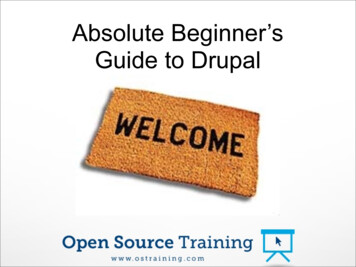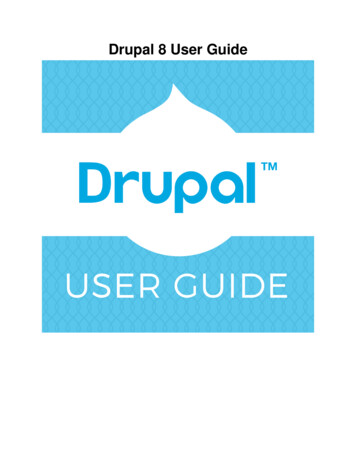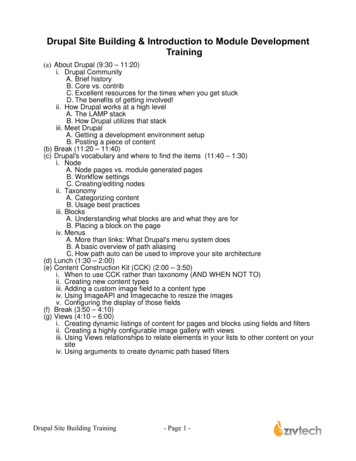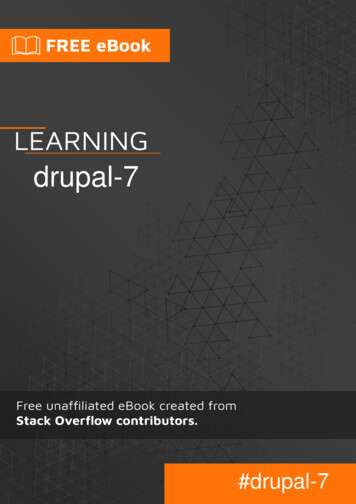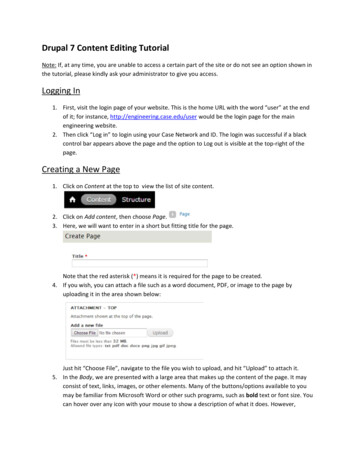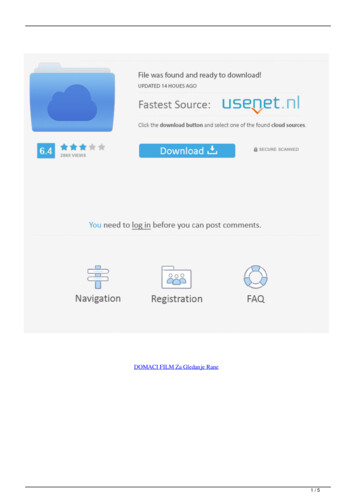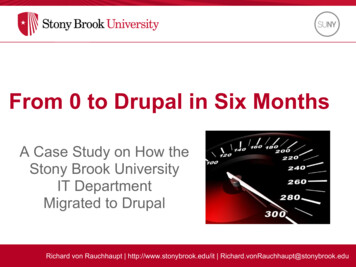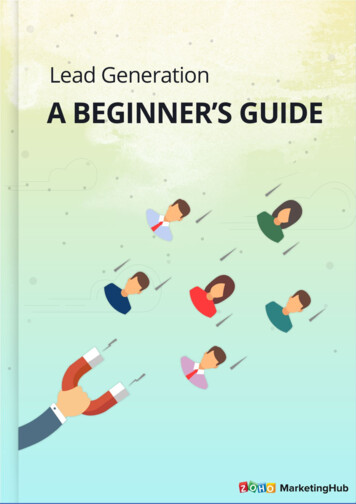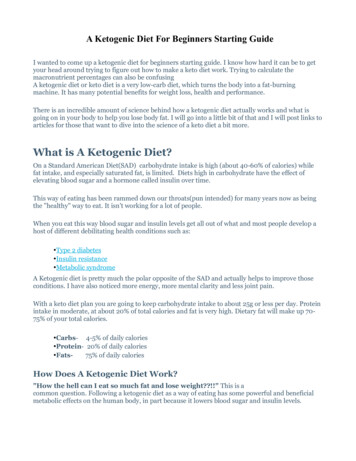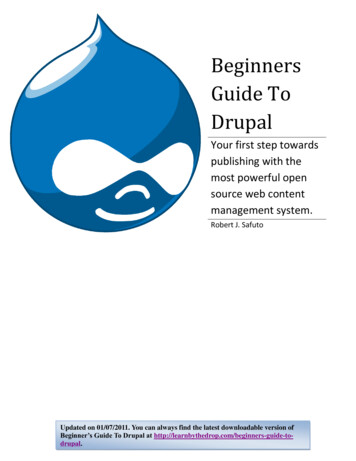
Transcription
BeginnersGuide ToDrupalYour first step towardspublishing with themost powerful opensource web contentmanagement system.Robert J. SafutoUpdated on 01/07/2011. You can always find the latest downloadable version ofBeginner’s Guide To Drupal at .
Beginners Guide To DrupalTable of ContentsBackground . 3What You Can Do With Drupal . 4Why You Should Use A System Like Drupal . 5Technical Requirements . 6Drupal Knowledge . 6Drupal Community . 8Drupal Primer . 9Spam Prevention. 17Managing Media . 19Commerce . 24Statistics . 24Social Networking . 25Hosting . 26Service Providers . 28Getting Started With Drupal . 28About Awakened Voice . 30This document is distributed under a Creative Commons Non-Commercial Share-Alike license. If you republishall or part of this document please include my name and link to www.awakenedvoice.com. Drupal is a registeredtrademark of Dries Buytaert.Page 2 of 30
Beginners Guide To DrupalThis very basic guide is intended to give beginning Drupal developers information tohelp them get started with the platform. It is barely possible to provide all theinformation necessary to excel at Drupal in just a few pages so I recommend that youdedicate some time each week to searching out new resources and tips on how toimprove your knowledge of the platform.This guide is a living document. As the Drupal platform changes I fully intend to update the document.This guide can also benefit from reader feedback. If you see inaccuracies or think that a particular pieceof information should be added to the guide please email me with the details of your input.BackgroundThe Drupal project was started in 2000 by a student in Belgium named Dries Buytaert. The code wasoriginally designed for a site called Drop.org. In 2001 the source code for this project was released asDrupal. More information on Drupal history is available at http://drupal.org/node/769. In 2007, Driesannounced the launch and venture funding of Acquia. Acquia is a commercial project that aims to“provide value-added software products and services” for Drupal.Major Release History Drupal 4.7 - May 1, 2006 Auto-complete Forms Multiple Block Regions Free Tagging Aggregator Enhancements Drupal 5.0 - January 15, 2007 Web-based Installer Updated Admin Pages URL Filtering Custom Content Types Drupal 6.0 - February 13, 2008 Open ID Support Localization Features Actions and Triggers Drag-and-Drop Admin Drupal 7.0 – January 5, 2011 Improved image handling More secure scheduling of tasksThis document is distributed under a Creative Commons Non-Commercial Share-Alike license. If you republishall or part of this document please include my name and link to www.awakenedvoice.com. Drupal is a registeredtrademark of Dries Buytaert.Page 3 of 30
Beginners Guide To Drupal Better what you see is what you get (WYSIWYG) editor supportRedesigned administrative user interfaceNew default themeWhat You Can Do With DrupalDrupal is an extremely flexible system that allows you to create a wide variety of websites, some ofwhich are summarized below.Website with Static ContentDrupal is a great tool for creating traditional websites that have a relatively static set of content. Thecore release of Drupal allows you to create as many unique pages as you like. Drupal also gives you theopportunity to set any particular page you create as the home page.Website with Dynamic ContentIn addition to static pages, the core Drupal release allows you to create a blog, upload file attachmentsand aggregate content from other sites. It's easy to add a blog or news updates to your static content.You could upload and share press releases or other company documents. You can pull in news thatrelates to your site from an RSS feed by using the aggregator module. People can subscribe to yourdynamic content by utilizing one of the many RSS feeds made available by the system.Single or Multi-Author BlogThe Drupal blog module allows each site user to have a blog. Even if the site has only one author,Drupal contains great features that allow you to get the full experience. Each blog has its own RSS feedfor easy subscription via a feed reader. Drupal allows you to freely add tags to each post, which youcan display as a cloud using the tagadelic module. Good spam protection is available as well. You canrequire that visitors sign up before commenting. Or you can use the Captcha, Mollom or Spam modulesto provide stronger spam protection.Community WebsiteDrupal contains a wide variety of features that make a community publishing site possible. The Drupalcore release includes a user account system. This allows users to register for an account with your site.Drupal core also includes a custom profile module that allows a site developer to set the types ofinformation they would like to capture in a user's profile. Users may also upload a small photo torepresent their profile. Modules such as Organic Groups allow you to create a full-featured communitywebsite.This document is distributed under a Creative Commons Non-Commercial Share-Alike license. If you republishall or part of this document please include my name and link to www.awakenedvoice.com. Drupal is a registeredtrademark of Dries Buytaert.Page 4 of 30
Beginners Guide To DrupalOpen Data PlatformDrupal can be used to import and serve data from the database in the form of tables, file downloads andcharts. Contributed modules such as Charts and Graphs, Data, Feeds and Views Bonus Pack go a longway in helping you to build this type of site.Drupal also contains robust user access features that allow a site administrator to specify the types ofcontent a user can create on the site. Site administrators can create various user access levels so thatsome users can have access to different features than others. A wide variety of contributed modulesextend the community experience with private messaging, user relationships, content ratings, contentforwarding and a lot more.Why You Should Use A System Like DrupalNotice that the title says, “a system like Drupal.” There are a wide variety of community and contentmanagement platforms available today. After you perform a detailed analysis you might decide thatDrupal is not for you. That's ok but you shouldn't settle for a system that doesn't have the characteristicsof a Drupal-based site.EconomicsSince Drupal is an open source project you don't have to pay any sort of license fee to access thesoftware. You may want to pay someone to help customize features and theme your site. But if you'rewilling to dive in and learn about the system you can do it all yourself.ExpandabilityA Drupal site can start out as a single author blog, migrate to a multi-author blog and then expand intoa user generated content community without changing platforms. You simply make the switch byturning on and configuring new features and defining new access roles.FeaturesBetween the core and contributed modules the Drupal platform allows you to do almost anything youwill need to do with your website. And if Drupal doesn't excel at a particular function it probablyintegrates with a service that can provide the function for you. One very good example of third-partyservice support involves integration with Google Analytics for advance statistics on your Drupal siteactivity. Drupal also integrates with anti-spam services like Akismet and Mollom, allowing the dataintensive task of content filtering to be handled by another server.This document is distributed under a Creative Commons Non-Commercial Share-Alike license. If you republishall or part of this document please include my name and link to www.awakenedvoice.com. Drupal is a registeredtrademark of Dries Buytaert.Page 5 of 30
Beginners Guide To DrupalCommunityWith many commercial systems you have to rely on the company that built the system to providesupport. With Drupal and other open source systems you can have the opportunity to get help from avery large community of developers and users of the system. The main Drupal community website atDrupal.org contains community generated documentation and a lively forum section where you canfind answers to your questions about the platform.Technical RequirementsBeginners should know some important information about Drupal requirements before they get starteddeveloping a site. You're going to need a web hosting account in order to get a website based on Drupalup and running. This will cost you anywhere from 7.95 to 50 per month depending on the features ofthe account. You can do more research in the hosting forum at Drupal.org. Whichever host you choosethere are two hosting features that are essential to building a Drupal site.1. MySQL Database - The database stores all of the essential information about the configurationand content on your site. MySQL version 4.1 or higher is highly recommended. Drupal 7requires MySQL 5.0.15 or higher.2. PHP - PHP provides the necessary functions for the Drupal software code to run on yourwebsite. PHP version 5.2 or higher is recommended, although PHP version 4.3.5 should workwith Drupal version 5 or 6. Drupal 7 requires PHP 5.2.5 or higher.You will also need FTP (short for File Transfer Protocol) access to your site. This is a standard featureof all hosting accounts and allows you to upload or download files between the web server and yourlocal machine. If you are new to FTP then you will need to install a program that allows you tointerface with your web server. Filezilla is a free FTP program that I use and recommend for you aswell.More detailed information on Drupal technical requirements is available at drupal.org/requirements.Drupal KnowledgeOne of the great challenges of a system like Drupal is the fact that universe of features, which is largeto begin with, is always expanding. As such, the many sources of knowledge about the platform arevery important to anyone researching or implementing the system.This document is distributed under a Creative Commons Non-Commercial Share-Alike license. If you republishall or part of this document please include my name and link to www.awakenedvoice.com. Drupal is a registeredtrademark of Dries Buytaert.Page 6 of 30
Beginners Guide To DrupalDrupal.orgThe official hub of the Drupal community is always the best place to start when searching for Drupalknowledge. The forum section contains active discussions on just about every Drupal topic that you canthink of. The Drupal Handbooks are a source of relatively static documentation about the platform. Thehandbooks also contain a section for listing Drupal videocasts. Videocasts allow you to watch step-bystep tutorials on customizing your Drupal install.BooksAs Drupal has grown in popularity the system has gained the attention of technical writers, some ofwhom have published print and e-books about Drupal. Here are some of the books available as ofJanuary 2011.Foundation Drupal 7Drupal 7 Module DevelopmentDrupal 6 Java ScriptDrupal MultimediaDrupal 6 Site Builder SolutionsPro Drupal DevelopmentSelling Online with DrupalUsing DrupalDrupal6 ThemesThis document is distributed under a Creative Commons Non-Commercial Share-Alike license. If you republishall or part of this document please include my name and link to www.awakenedvoice.com. Drupal is a registeredtrademark of Dries Buytaert.Page 7 of 30
Beginners Guide To DrupalNote: The above images contain affiliate links which help to compensate me for the time spent keepingthis document up to date.Enthusiast WebsitesA very large community of Drupal enthusiasts has chosen to share knowledge and provide support forDrupal via their personal websites. Here is a list of just a few destinations where you can findadditional knowledge and support on the platform. Drupal D
Drupal Multimedia Drupal 6 Site Builder Solutions Pro Drupal Development Drupal 6 Themes Selling Online with Drupal Using Drupal . Beginners Guide To Drupal This document is distributed under a Creative Commons Non-Commercial Share-Alike license. If you republish all or part of this document please include my name and link to www.awakenedvoice.com. Drupal is a registered „ Your first step .
